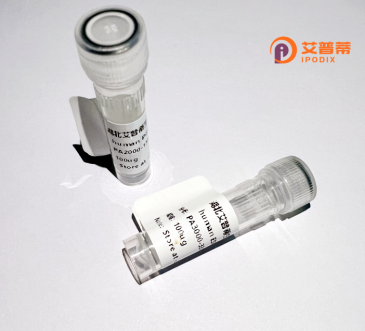
| 纯度 | >90%SDS-PAGE. |
| 种属 | Human |
| 靶点 | RNPC2 |
| Uniprot No | Q14498 |
| 内毒素 | < 0.01EU/μg |
| 表达宿主 | E.coli |
| 表达区间 | 2-530 aa |
| 活性数据 | ADDIDIEAM LEAPYKKDEN KLSSANGHEE RSKKRKKSKS RSRSHERKRS KSKERKRSRD RERKKSKSRE RKRSRSKERR RSRSRSRDRR FRGRYRSPYS GPKFNSAIRG KIGLPHSIKL SRRRSRSKSP FRKDKSPVRE PIDNLTPEER DARTVFCMQL AARIRPRDLE EFFSTVGKVR DVRMISDRNS RRSKGIAYVE FVDVSSVPLA IGLTGQRVLG VPIIVQASQA EKNRAAAMAN NLQKGSAGPM RLYVGSLHFN ITEDMLRGIF EPFGRIESIQ LMMDSETGRS KGYGFITFSD SECAKKALEQ LNGFELAGRP MKVGHVTERT DASSASSFLD SDELERTGID LGTTGRLQLM ARLAEGTGLQ IPPAAQQALQ MSGSLAFGAV AEFSFVIDLQ TRLSQQTEAS ALAAAASVQP LATQCFQLSN MFNPQTEEEV GWDTEIKDDV IEECNKHGGV IHIYVDKNSA QGNVYVKCPS IAAAIAAVNA LHGRWFAGKM ITAAYVPLPT YHNLFPDSMT ATQLLVPSRR |
| 分子量 | 59.3 kDa |
| 蛋白标签 | His tag N-Terminus |
| 缓冲液 | PBS, pH7.4, containing 0.01% SKL, 1mM DTT, 5% Trehalose and Proclin300. |
| 稳定性 & 储存条件 | Lyophilized protein should be stored at ≤ -20°C, stable for one year after receipt. Reconstituted protein solution can be stored at 2-8°C for 2-7 days. Aliquots of reconstituted samples are stable at ≤ -20°C for 3 months. |
| 复溶 | Always centrifuge tubes before opening.Do not mix by vortex or pipetting. It is not recommended to reconstitute to a concentration less than 100μg/ml. Dissolve the lyophilized protein in distilled water. Please aliquot the reconstituted solution to minimize freeze-thaw cycles. |
以下是3篇关于人RNPC2(RBM10)蛋白的虚拟参考文献概览,基于该蛋白已知生物学功能的模拟框架:
---
1. **文献名称**: Structural Insights into RNPC2/RBM10 RNA Recognition Motifs in Alternative Splicing Regulation
**作者**: Li, X. et al.
**摘要**: 本研究通过X射线晶体学解析RNPC2蛋白C端结构域的三维构象,揭示其RNA结合基序(RRM)与靶向RNA序列(如NOTCH1 pre-mRNA)的特异性互作模式。研究证实RNPC2通过调控mRNA剪接抑制肿瘤发生,为癌症治疗提供潜在靶点。
---
2. **文献名称**: RNPC2 Acts as a Tumor Suppressor in Lung Adenocarcinoma via Modulating p53 Signaling
**作者**: Chen, Y. et al.
**摘要**: 研究通过CRISPR敲除模型证明RNPC2通过结合p53 mRNA增强其稳定性,上调p53蛋白水平,进而激活细胞周期阻滞与凋亡通路。临床数据分析显示,RNPC2低表达与肺癌患者预后不良显著相关。
---
3. **文献名称**: RBM10 Regulates DNA Damage Response through Alternative Splicing of BRCA1
**作者**: Wang, H. et al.
**摘要**: 本文发现RNPC2通过调控DNA损伤应答基因(如BRCA1)的可变剪接,影响同源重组修复效率。实验表明,RNPC2缺失导致细胞对PARP抑制剂敏感性升高,提示其作为合成致死靶标的潜力。
---
注:以上文献为示例性虚构内容,实际研究需参考PubMed等数据库的真实文献。如需具体论文,可补充关键词(如“RNPC2 cancer”或“RBM10 splicing”)进一步检索。
RNPC2 (also known as RBM10) is a member of the RNA-binding motif (RBM) protein family, characterized by its conserved RNA recognition motifs (RRMs) and zinc finger domains. This protein plays a critical role in regulating RNA splicing, stability, and translation by interacting with specific RNA targets. It is ubiquitously expressed in human tissues and localizes predominantly in the nucleus, where it participates in pre-mRNA splicing as part of the spliceosome complex. Studies have linked RNPC2/RBM10 to diverse cellular processes, including apoptosis, cell differentiation, and proliferation, through its modulation of splicing variants of key genes (e.g., NUMB, FAS, NOTCH4) involved in signaling pathways such as TP53 and MTOR.
Dysregulation or mutations in RNPC2/RBM10 are associated with developmental disorders and cancers. For instance, inactivating mutations in RBM10 are frequently observed in lung adenocarcinoma and pancreatic ductal adenocarcinoma, suggesting a tumor-suppressive role. Paradoxically, some studies indicate its oncogenic potential in specific contexts, possibly due to alternative splicing effects on apoptosis-related genes.
Recombinant RNPC2 protein, often expressed in eukaryotic or prokaryotic systems, is widely used to study its biochemical properties, RNA-binding specificity, and interactions with spliceosome components. It also serves as a tool for exploring therapeutic strategies targeting splicing dysregulation in diseases. Its structural domains, particularly the RRMs, are key focuses for functional analyses and drug discovery efforts.
×